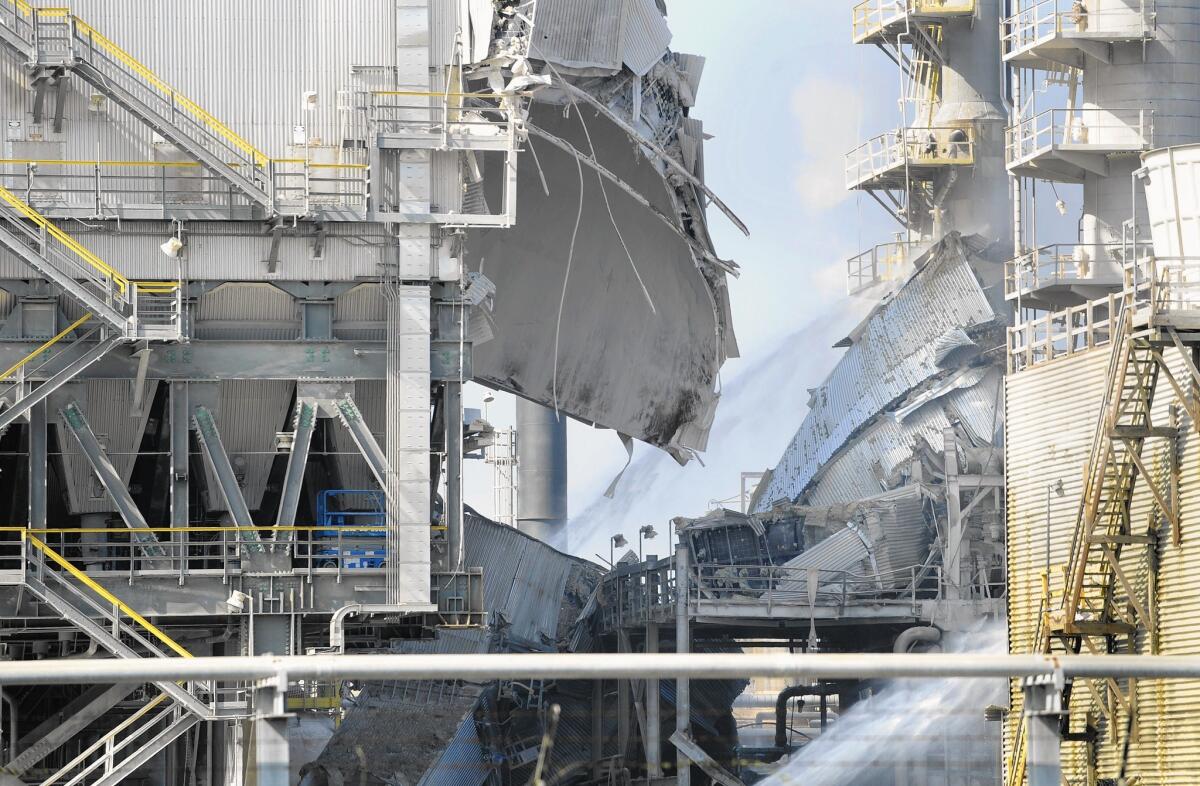Air regulators weigh return of full operations at Exxon Mobil’s Torrance refinery

An explosion damaged the Exxon Mobil refinery in Torrance in February 2015. Since the explosion, the refinery has operated at less than 20% of its normal capacity.
For a year, Los Angeles area motorists have seen their gasoline prices soar as high as $1.50 a gallon more than the rest of the nation following an explosion at Exxon Mobil’s Torrance refinery that destroyed the plant’s pollution control system and constrained California inventories.
Angry neighbors called for a permanent shutdown of the facility after reports revealed that the February 2015 explosion, which triggered state and federal investigations, could have unleashed harmful chemicals into their community.
On Saturday, the South Coast Air Quality Management District will hold a hearing at the Torrance City Hall to review Exxon Mobil’s request to fully restore the refinery, which usually provides a fifth of the refined gasoline capacity in Southern California and 10% of the statewide capacity.
SIGN UP for the free California Inc. business newsletter >>
Although gasoline prices in recent weeks have turned upward, the Torrance refinery’s return to service could at least help narrow the ongoing gap between the Los Angeles region and other parts of the country.
Since the explosion, the refinery has operated at less than 20% of its normal capacity.
“Once Exxon Mobil starts producing, that’s going to put downward pressure on prices,” said Gordon Schremp, senior fuels analyst for the California Energy Commission.
California prices are almost always higher than national prices, driven up by higher-than-average taxes and fees, state requirements to produce special low-pollution blends and the relatively small number of refineries in the state. But with the Torrance plant producing a fraction of its normal capacity, Schremp said, California prices have been consistently running 20 cents more than the national average.
Industry analysts speculated that the Torrance facility would return to service by July 2015. State agencies and regulators suggested that the plant would return to full operation by the end of 2015 and, later, by February 2016.
None of the predictions proved true, and the long outage drove up gasoline prices in the L.A. region, even as the nationwide average kept falling. Some gas stations in downtown L.A. posted prices of more than $5 for a gallon of regular while the nationwide average was $2.77.
Consumer Watchdog, an advocacy organization, for months has criticized oil companies for gouging consumers throughout the Exxon Mobil refinery outage as the companies reaped record gross profits from the high gasoline prices.
“The big problem for this market has been that when Exxon went down for more than a year, 20% of our gasoline in Southern California went away,” said Jamie Court, president of Consumer Watchdog. “It’s opened a lot of eyes.”
Returning the Torrance refinery to full service will set the stage for the sale of the plant to New Jersey-based PBF Energy, which announced last fall that it was acquiring the facility. Exxon Mobil and PBF said they anticipate closing on the deal by mid-2016.
PBF has said it would not acquire the refinery until Exxon Mobil restores full operations.
The acquisition, experts said, also could help lower California gas prices, depending on how aggressively PBF decides to operate.
The company says it intends to fully utilize the Torrance plant.
“PBF is a competitive, growth-oriented, merchant refiner that is excited to be expanding into Southern California,” said Michael Karlovich, a PBF spokesman. “After we purchase the Torrance refinery we will begin selling into an established wholesale market, so having a new merchant refiner in the region … should further increase competitiveness.”
Schremp said Exxon Mobil’s plans for safely returning Torrance to full operation appear to have regulatory support. Once Exxon Mobil has approval to fully restore operations, it will take several days for the plant to reach full capacity.
Todd Spitler, an Exxon Mobil spokesman, said the company could not speculate on the timing of the restart.
“We look forward,” Spitler said, “to sharing the details of our comprehensive plan to safely restart the Torrance refinery and ensure a productive hearing.”
Twitter: @ivanlpenn
MORE FROM BUSINESS
Prudential pulls a fast one on long-term care insurance policyholders
Yamashiro may get booted from its Hollywood Hills building for something more upscale
After Tesla Model 3 unveiling, Elon Musk faces big challenges to deliver cars
More to Read
Inside the business of entertainment
The Wide Shot brings you news, analysis and insights on everything from streaming wars to production — and what it all means for the future.
You may occasionally receive promotional content from the Los Angeles Times.











